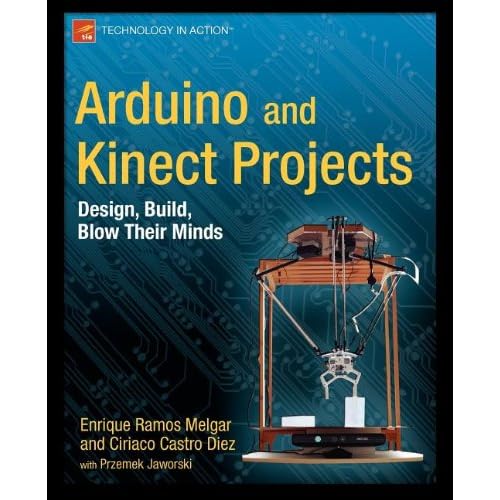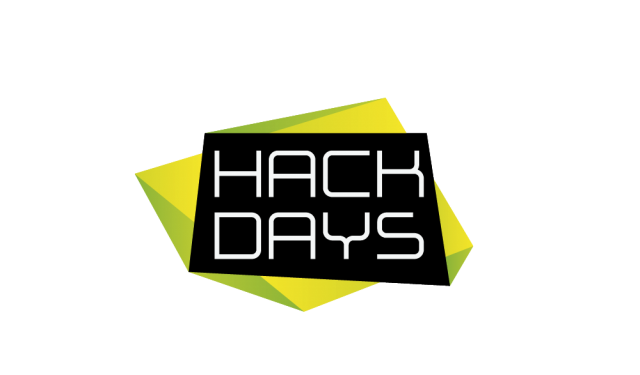
Przemek contributed a chapter to Arduino and Kinect Projects book, written originally by Enrique Melgar Ramos and Ciriaco Castro Diez. The chapter is a step-by-step tutorial of how to build a robotic drawing arm, driven by Kinect sensor and natural gestures. Book describes 10 do-it-yourself projects using Arduino and Kinect, original description from Amazon is as follows:
”
If you’ve done some Arduino tinkering and wondered how you could incorporate the Kinect?or the other way around?then this book is for you. The authors of Arduino and Kinect Projects will show you how to create 10 amazing, creative projects, from simple to complex. You’ll also find out how to incorporate Processing in your project design?a language very similar to the Arduino language.
The ten projects are carefully designed to build on your skills at every step. Starting with the Arduino and Kinect equivalent of “Hello, World,” the authors will take you through a diverse range of projects that showcase the huge range of possibilities that open up when Kinect and Arduino are combined.
- Gesture-based Remote Control. Control devices and home appliances with hand gestures.
- Kinect-networked Puppet. Play with a physical puppet remotely using your whole body.
- Mood Lamps. Build your own set of responsive, gesture controllable LED lamps.
- Drawing Robot. Control a drawing robot using a Kinect-based tangible table.
- Remote-controlled Vehicle. Use your body gestures to control a smart vehicle.
- Biometric Station. Use the Kinect for biometric recognition and checking Body Mass Indexes.
- 3D Modeling Interface. Learn how to use the Arduino LilyPad to build a wearable 3D modelling interface.
- 360? Scanner. Build a turntable scanner and scan any object 360? using only one Kinect.
- Delta Robot. Build and control your own fast and accurate parallel robot.
”
Video demonstrating the robot described in mentioned chapter is on vimeo.
If you’re interested in tinkering with kinetic installations, this is definitely the position to get!
Link :
http://www.amazon.com/Arduino-Kinect-Projects-Design-Build/dp/1430241675

Przemek napisał rozdział do książki ‘Arduino and Kinect Projects’ , napisanej przez Enrique Melgar Ramos’a i Ciriaco Castro. Rozdział opisuje krok po kroku jak zbudować robotyczne ramię rysujące po papierze pisakiem, sterowane sensorem Kinect i naturalnymi gestami wykonywanymi przez użytkownika. Poza tym książka opisuje 10 projektów w stylu ‘zrób-to-sam’, wszystkie z nich używają Arduino i Kinecta. Oryginalny opis ze strony Amazon.com poniżej :
”
If you’ve done some Arduino tinkering and wondered how you could incorporate the Kinect?or the other way around?then this book is for you. The authors of Arduino and Kinect Projects will show you how to create 10 amazing, creative projects, from simple to complex. You’ll also find out how to incorporate Processing in your project design?a language very similar to the Arduino language.
The ten projects are carefully designed to build on your skills at every step. Starting with the Arduino and Kinect equivalent of “Hello, World,” the authors will take you through a diverse range of projects that showcase the huge range of possibilities that open up when Kinect and Arduino are combined.
- Gesture-based Remote Control. Control devices and home appliances with hand gestures.
- Kinect-networked Puppet. Play with a physical puppet remotely using your whole body.
- Mood Lamps. Build your own set of responsive, gesture controllable LED lamps.
- Drawing Robot. Control a drawing robot using a Kinect-based tangible table.
- Remote-controlled Vehicle. Use your body gestures to control a smart vehicle.
- Biometric Station. Use the Kinect for biometric recognition and checking Body Mass Indexes.
- 3D Modeling Interface. Learn how to use the Arduino LilyPad to build a wearable 3D modelling interface.
- 360? Scanner. Build a turntable scanner and scan any object 360? using only one Kinect.
- Delta Robot. Build and control your own fast and accurate parallel robot.
”
Video pokazujące opisywanego robota w akcji jest do obejrzenia na vimeo.
Książkę można kupić klikając na link poniżej :
http://www.amazon.com/Arduino-Kinect-Projects-Design-Build/dp/1430241675
 Hackdays jest to wydarzenie skupiające artystów, profesjonalnych twórców, eksperymentatorów oraz wszelakij maści kreatywne umysły w celu wymiany informacji i wzajemnej inspiracji. Temat luźno orbituje wokół zagadnień ‘namacalnej komputacji” (physical computing) oraz interakcji i użycia multimediów w sztuce i designie.
Hackdays jest to wydarzenie skupiające artystów, profesjonalnych twórców, eksperymentatorów oraz wszelakij maści kreatywne umysły w celu wymiany informacji i wzajemnej inspiracji. Temat luźno orbituje wokół zagadnień ‘namacalnej komputacji” (physical computing) oraz interakcji i użycia multimediów w sztuce i designie.